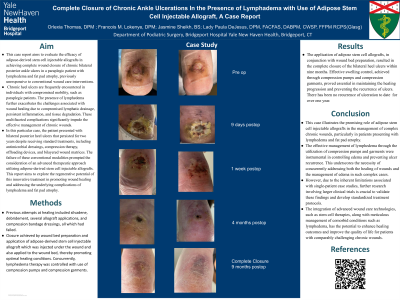Case Series/Study
(CS-164) Complete Closure of Chronic Ankle Ulcerations in the Presence of Lymphedema with Use of Adipose Stem Cell Injectable Allograft
Friday, May 2, 2025
7:45 PM - 8:45 PM East Coast USA Time

Lady Paula DeJesus, DPM; Francois Lokenye, DPM; Jasmine Shaikh, MS2
Introduction: Chronic heel ulcerations present substantial challenges to wound healing, particularly in patients with lymphedema. Lymphedema results in impaired lymphatic drainage, chronic inflammation, and tissue breakdown, complicating the healing process. This case report investigates the use of adipose stem cell injectable allograft as an advanced therapy to achieve complete wound closure in a paraplegic patient suffering with bilateral chronic posterior ankle ulcers further complicated by lymphedema and fat pad atrophy.
Methods: The patient initially presented with bilateral posterior heel wounds for two years that were treated using antimicrobial dressings, bilayered wound matrix, compression therapy, and offloading devices. These treatments failed. As a result, advanced management was introduced by sharp wide excisional debridement with application of adipose-derived stem cell injectable allograft, thereby promoting optimal healing conditions. Concurrently, lymphedema therapy was controlled with use of compression pumps and compression garments.
Results: Complete closure of bilateral ulcers following the application of adipose stem cell allografts occurred in 9 months. Effective swelling control, achieved through compression pumps and compression garments, proved essential in maintaining the healing progression and preventing the recurrence of ulcers. There has been no recurrence of ulceration for one year.
Discussion: This case illustrates the potential of adipose stem cell injectable allografts as a transformative treatment for complex wounds associated with lymphedema. It highlights that a combination of advanced wound care strategies and diligent edema management can result in successful healing outcomes, even in patients with significant comorbidities. Further research is necessary to explore the broader applicability of this innovative approach, which could lead to enhanced protocols and outcomes in managing challenging wound care cases.
Methods: The patient initially presented with bilateral posterior heel wounds for two years that were treated using antimicrobial dressings, bilayered wound matrix, compression therapy, and offloading devices. These treatments failed. As a result, advanced management was introduced by sharp wide excisional debridement with application of adipose-derived stem cell injectable allograft, thereby promoting optimal healing conditions. Concurrently, lymphedema therapy was controlled with use of compression pumps and compression garments.
Results: Complete closure of bilateral ulcers following the application of adipose stem cell allografts occurred in 9 months. Effective swelling control, achieved through compression pumps and compression garments, proved essential in maintaining the healing progression and preventing the recurrence of ulcers. There has been no recurrence of ulceration for one year.
Discussion: This case illustrates the potential of adipose stem cell injectable allografts as a transformative treatment for complex wounds associated with lymphedema. It highlights that a combination of advanced wound care strategies and diligent edema management can result in successful healing outcomes, even in patients with significant comorbidities. Further research is necessary to explore the broader applicability of this innovative approach, which could lead to enhanced protocols and outcomes in managing challenging wound care cases.

.jpg)